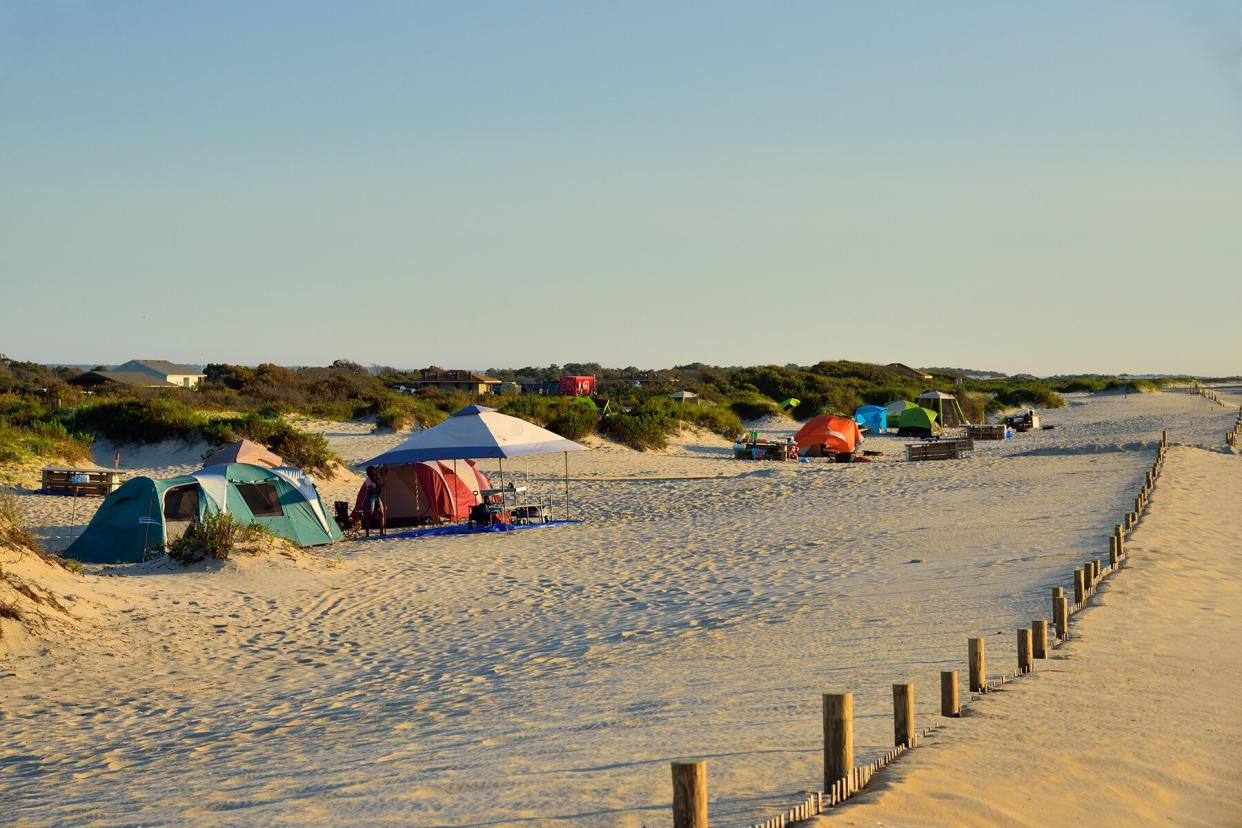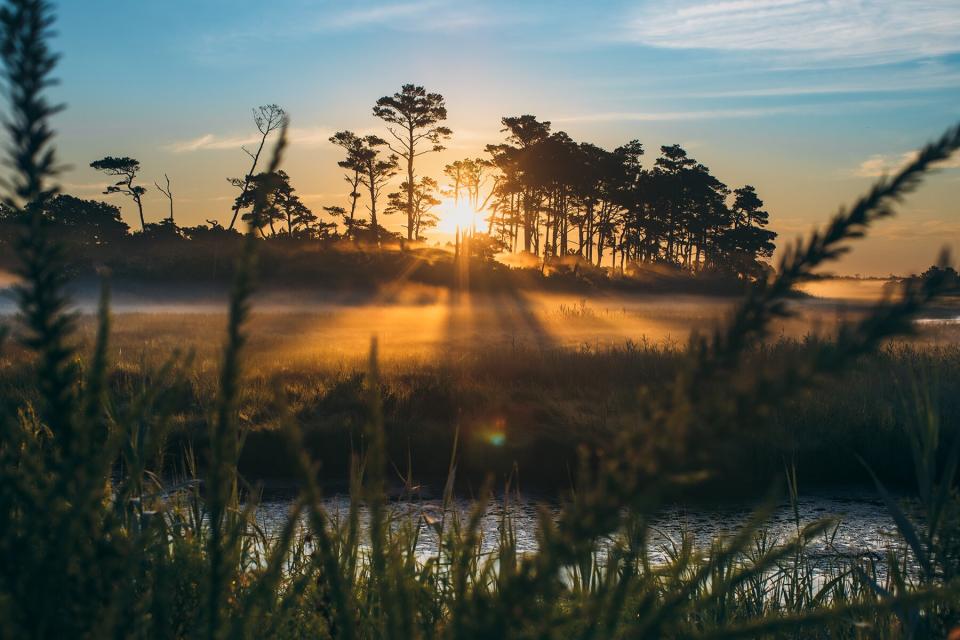This Island Spanning Maryland and Virginia Is the Perfect Beach Getaway — With Wild Horses, Kayaking, and Beach Camping

Joesboy/Getty Images
Smack in the middle of the East Coast, roughly three hours by car from Philadelphia, Assateague Island National Seashore is a 48,000-acre preserved stretch of coastal wilderness on a barrier island along the Atlantic. Assateague not only remains one of the largest mid-Atlantic barrier islands to have a continuum of intact coastal habitats, but it does so with little to no human interference.
The ecosystem here is so valued, in fact, that it takes three separate agencies to manage it (National Park Service, U.S. Fish and Wildlife Service, and the Maryland Department of Natural Resources). Add to that the fact that the island is split between two different states — Maryland and Virginia — and it's easy to see why travelers often throw up their hands in confusion before ever setting foot on the rugged, windswept shoreline.
"The geography of the island is in a state of constant flux," says Liz Davis, chief of interpretation and education for Assateague Island National Seashore. "[It's] continuously being reshaped by the elemental forces of wind and water. A powerful storm can dramatically alter the shoreline in a matter of hours."
But other forces are at play here, too. For a quick tutorial on how to make the most of this extreme wilderness at the edge of the sea, read on.
Assateague Island Horses
Wild horses have been present on Assateague for hundreds of years — they originally descended from domestic horses that survived a shipwreck off the Virginia coast in the late 17th century (at least, that's how the legend goes). You're better off catching them on the Maryland side of the island. (Then again, if you're hoping to ride the horses, you'll want to head to the Virginia side — unlike in Maryland, which has restrictions on horseback riding in the summer and fall, Virginia offers them year-round.) Wildlife tours, providing a comprehensive look at the many species that call this island home, are available, too.
In the spring, it's not uncommon to see mares strolling around with their newborn foals. If you happen to witness the tiny horses taking their first wobbly steps, be sure to give them a wide berth. Davis recommends standing back at least 40 feet (or a bus length) from young families. "Mares and foals need that bonding time," she explains.
Water Activities on the Island
With 12 miles of beach on the Maryland side, most visitors head straight to the coast, and with good reason. During the summer, there are lifeguard-protected spots in both the Maryland and Virginia districts, with water temperatures reaching into the 70s.
But there are lots of activities available to travelers, too. From dolphin-watching tours to surf fishing to clamming, there are plenty of ways to pass the time. Just be sure to stop by the visitor center, as certain activities, like kayaking, require reservations.

Zach Frailey/Getty Images
When to Avoid the Crowds
For a more secluded way to spend your time on the water, Davis recommends heading to the bay (western) side of the island, which is less frequented by crowds. "I'll spend most of my time kayaking, wading, swimming, clamming, and crabbing in the shallow, warm bay waters. I often feel like I have the whole bay area to myself," she says.
For a guided kayaking expedition, Assateague Explorer offers three-hour tours during which you'll find yourself paddling alongside wild ponies, bald eagles, and other wildlife.
Driving on the Beach
There are two entrances to Assateague Island National Seashore: one on the north end, just eight miles from Ocean City, Maryland, and another on the south end, two miles from Chincoteague, Virginia. While you can't travel from one entrance to the other (you'll have to return to the mainland to do that), you can access certain areas of the beach with your car.
To do that, you'll need a four-wheel drive vehicle, along with an Over Sand Vehicle permit (obtainable from Toms Cove Visitor Center, for $110 to $200, depending on the type of access desired).
"Driving on the beach is a unique privilege not found in too many areas. It can feel like a real 'getaway' once you leave the paved roads," says Davis.
Best Time to Visit Assateague Island for Good Weather
While the seashore stays open year-round, the climate can vary widely between the four seasons. For sunny days, your best bet is a visit in July or August, when temperatures reach the high 80s and 90s, and the ocean is at its warmest. However, this is also peak tourist season, which means bigger crowds.
And then there's the heat. "Summers at Assateague are generally hot and humid," says Davis. Plus, you'll need to be prepared with plenty of insect repellent and protective clothing, as mosquitoes, biting flies, gnats, and ticks are an ongoing nuisance throughout the summer. (Pro tip: Check the weather forecast before your trip to avoid western winds, which can blow biting flies from the marshes onto the beach.)
Prefer a bit more solitude? Opt for a September trip. "Fall can be a really nice time to visit," says Davis. "The humidity drops, but the temperature still feels like summer, and the water is still warm."
Assateague Island Camping

Joesboy/Getty Images
Camping on Assateague offers a unique thrill. With waves crashing outside your tent, and horses roaming free along the beach, you'll wake up each morning feeling like you're inside a David Attenborough documentary. But there are a few things to keep in mind. For instance, use special sand stakes when securing your tent. Unlike the skinny metal stakes that come in the package, these specialty items are sturdier, and will do a better job at keeping your tent anchored in the wind and sand.
Another piece of equipment worth the investment is a screen tent. These larger shelters can be set up over your picnic table, so you can enjoy breakfast and dinner without worrying about invading mosquitoes. It also provides shade on particularly hot days.
And speaking of food, make sure to bring proper storage. In between meals, all food must be stored in your vehicle or packed away inside sturdy, latched containers that can be slipped inside cabinets under your picnic table. All coolers must be secured with a nylon strap, too. This is partly for your safety, but also for the horses. As the signs warn: "A fed horse is a dead horse."

